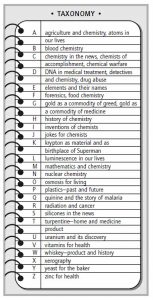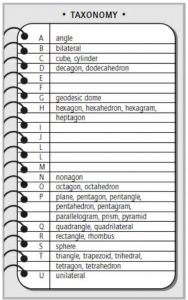Taxonomies
The ABC’s of Word Power
What is it?
 Alphabetical lists of terms related to a topic or subject that develops skills of categorization.
Alphabetical lists of terms related to a topic or subject that develops skills of categorization.
Slogan: Words are free!
Skills Addressed:
• Organizing prior, ongoing, and new knowledge
• Focusing on topic
• Taking notes
• Expanding vocabulary
• Building a personal thesaurus
• Developing cooperative and shared learning experiences
• Listening to others
Prerequisites
• Knowledge of alphabet
• Associating words with central topic
• Ability to work individually and cooperatively
• Some knowledge of spelling
Steps Involved
1. Each participant works alone and thinks of as many words that relate to the topic being studied.
2. Students enter each work next to its initial letter
3. Students work for three or four minutes without talking to anyone in the class
4. Students then collaborate by forming small groups and share their words, adding them to their personal Taxonomies
5. Whole class forms a group to cross-pollinate.
6. Students contribute words to the group by saying, “I have a word on the topic of……….. The word is ………”
7. Everyone adds the word to their Taxonomy.
Other procedures can be found in Writing As Learning.
Related Learning Principles
• Focusing on a topic, concept, or idea enhances learning
• Enlarging vocabulary provides access to new ideas and concepts
• Advance organizing and assessment of prior knowledge adds to new knowledge
• Ongoing natetaking reinforces memory
• Collecting words as concepts for text composing builds confidence for composing
Application
This strategy is for all grade levels and content areas. It serves as the foundation for listening, skimming text for important vocabulary, keeping track of essential information, taking notes, and having a starting point for writing. When students keep their Taxonomies in a notebook with a table of contents, they have an invaluable reference of their subject area words and topics.
Taxonomy Especially for Kindergarten and First Grade
On the very first day, or by the first week of school, set up a large chart with the alphabet written vertically. Head it “Roster of Names.” Tell the students that this list (which you call a Taxonomy) is very important because it tells “who lives in this class.” To develop the roster, ask each student to say her or his name using this form: “My name is Ebony and it begins with the letter E.” Then write the student’s name on the roster of names. You can then use the roster to introduce initial letter sounds, variations in spelling, alphabetical order, and information that can be graphed. By asking students questions such as the following, they can obtain varied information from a simple roster.
How many students are in this class?
Which letter has the most names?
Which letters have no names?
Which names sound the same but are spelled differently?
Who can read a name that begins with the letter___?
Taxonomies in the Upper Grades Through High School

While Taxonomies are valuable in all grades, they are essential in the upper grades, as they become the word carriers for the topic. In the upper grades, therefore, students should maintain Taxonomies across the curriculum, from mathematics through music, and for every topic that requires in-depth factual knowledge.
Strategy Source: Rothstein, Andrew S.; Rothstein, Evelyn B.; Lauber, Gerald. Writing as Learning . SAGE Publications. Kindle Edition.
